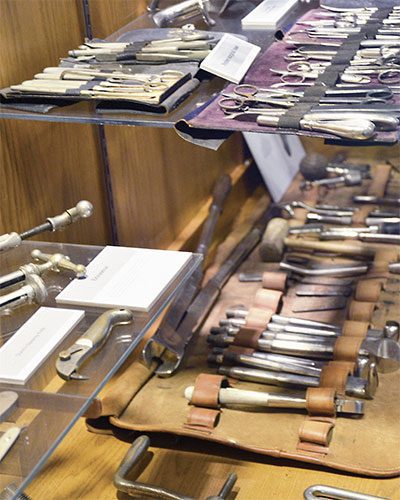There may be disputes about when humans began domesticating horses, but there is no argument that horses have helped shape human history.
We know Chinese equine veterinary medicine, including herbal treatments and acupuncture, dates back thousands of years, but there’s no agreement on the date, or even century. We do know the year their health and care became part of the formal curriculum of veterinary colleges. The year was 1761 and the location was the first veterinary school in the world, in Lyon, France. Equine anatomy as part of a formal curriculum has been studied by veterinarians since then, for more than 250 years.
Now, Spartans have the opportunity to gain a better understanding of the role that equine anatomy has played in the genesis of veterinary medicine. “The History of Equine Anatomy in Veterinary Medicine,” curated by Health Sciences Educational Technology Librarian Andrea C. Kepsel, and features some of the most important artifacts on equine anatomy from the MSU Libraries’ distinguished Beaudette Veterinary History Collection.

MSU’s Beaudette Collection was acquired in 1957 by Dr. J. Fred Smithcors, professor of anatomy at the MSU College of Veterinary Medicine and veterinary historian. The collection, which originally included over 250 rare books and manuscripts, has grown to more than 1,500 items. It is one of the largest and most distinguished collections of the history of veterinary medicine.
The exhibit includes 45 rare instruments from the 18th century, and more than 150 19th-century veterinary instruments that are on loan to the MSU College of Veterinary Medicine from the Wisconsin Veterinary Medical Association’s “Turn of the Century Museum.” The original exhibit for this museum was designed and constructed by Fred Born (MSU DVM ‘62) in 2011 to mark the 250th anniversary of the first veterinary medical school in the world.
Born’s exhibit was first displayed at the American Veterinary Medical Association’s convention in St. Louis, Missouri in 2011 as part of the “Vet 2011” global celebrations. It was also displayed at other AVMA conventions across the country. In 2012, the collection moved to the second floor of the MSU College of Veterinary Medicine. Born oversaw the exhibit set-up when he was on campus in June 2012 for the Class of 1962’s reunion. He graciously granted permission for the inclusion of these items in the “History of Equine Anatomy in Veterinary Medicine” exhibit.
The exhibit is a great opportunity for the public and members of the MSU community, particularly veterinary students, to explore the roots of veterinary medicine. The exhibit will be on display on the 1st floor of the Main Library until March 31st.

